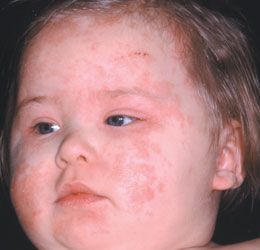Toddler Who "Caught Psoriasis" at Her Day-Care Center
The parents of this 12-month-old girl are concerned that their daughter “caught” psoriasis at her day-care center. The rash had been present for at least 6 months, after which it cleared significantly, only to return weeks later. The child does not seem to be bothered by it.

THE CASE: The parents of this 12-month-old girl are concerned that their daughter “caught” psoriasis at her day-care center. The rash had been present for at least 6 months, after which it cleared significantly, only to return weeks later. The child does not seem to be bothered by it.
Your examination reveals an erythematous rash with yellow greasy scale that is present as arcuate lesions over the anterior face and chest. The borders of the lesion are reasonably well demarcated but without definite papules.
(Answer and discussion on next page.)
Seborrhea is the correct answer.

DISCUSSION:Infantile seborrhea has many of the features of the other papulosquamous conditions listed, but the diagnosis is most commonly clinically evident on examination alone. If you are unsure, a KOH preparation will quickly sort out the dermatophytes. Also, the lack of itch makes atopic dermatitis very unlikely.
The difficulty arises in excluding psoriasis. Many consultants consider that there is significant overlap between seborrhea and psoriasis because many children with seborrhea also have features of psoriasis. I like to reserve my final thoughts; I am not comfortable excluding psoriasis until I have seen a rapid response to therapy, and until I see that this response continues if the condition recurs.
Pityrosporum ovale-yeast commonly found as part of the skin’s normal microflora-is the most likely cause of this condition. There are a number of immunologic and biochemical theories to explain individual susceptibility or causation but, for the clinician, the often rapid and complete response to topical azoles is strong evidence that this organism plays a significant role in the etiology.
Web Poll
|
Web Survey
Case and images courtesy of Kirk Barber, MD, Alberta Children’s Hospital.
Recognize & Refer: Hemangiomas in pediatrics
July 17th 2019Contemporary Pediatrics sits down exclusively with Sheila Fallon Friedlander, MD, a professor dermatology and pediatrics, to discuss the one key condition for which she believes community pediatricians should be especially aware-hemangiomas.




















